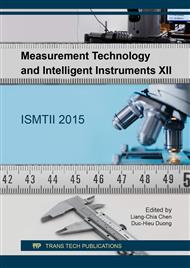p.283
p.289
p.295
p.303
p.309
p.317
p.323
p.329
p.335
Relationship between Coordinate Transformation Uncertainty and Arrangement of Common Reference Points in Large-Scale Metrology
Abstract:
Large-scale coordinate measurement frequently involves unifying coordinate frames of individual measurement systems by aligning two sets of common reference points, which is called coordinate transformation. During this transformation process, some uncertainty is introduced into the final measurement results from common points. This paper studies the relationship between this introduced uncertainty and common points in order to minimize it. First, an uncertainty estimation model of coordinate transformation is developed to quantify the introduced uncertainty. Then the relationship between the introduced uncertainty and the arrangement of the common points is simulationally and experimentally investigated and some feasible and efficient arrangements are proposed in view of minimizing it.
Info:
Periodical:
Pages:
309-314
Citation:
Online since:
September 2017
Authors:
Price:
Сopyright:
© 2017 Trans Tech Publications Ltd. All Rights Reserved
Share:
Citation:


